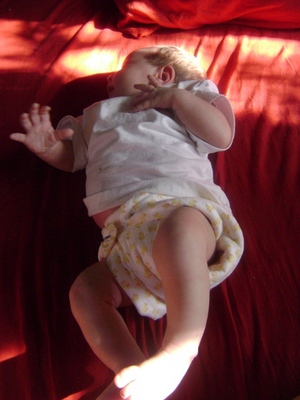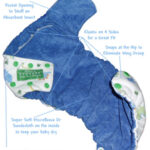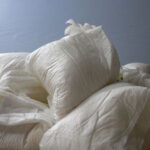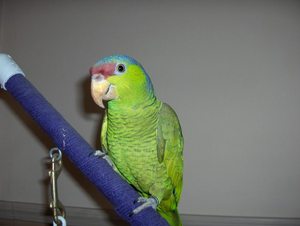One of the most-often-cited reasons to cloth diaper your baby is to save money. In truth, though, the most popular options today present a huge upfront cost, which is simply insurmountable to those folks who could most benefit from the savings of cloth. The solution? Go old school. In this article, I will give you a brief run-down of how to assemble a starter stash of diapers for next to nothing, and how to keep costs down long-term.
So, what’s the secret to a cheap stash? Two things: go flat, and go second-hand. The cloth diaper in its simplest form is merely a square or rectangle of cloth which is folded and pinned on a baby. Somewhere along the lines, though, this type of diaper got a bad reputation. Flats are too complicated, too leaky, too much trouble. Even the majority of mothers who use cloth diapers don’t use flats as diapers. In reality, though, flats are simple to use and even simpler to maintain, giving them a distinct edge over other forms of cloth diapers. You don’t even need a washer and dryer to properly maintain flat diapers, although they certainly make it easier.
Make this your motto in diapering: What would Grandma do?
First things first: what do you need to get started? You need diapers, pins, covers, and perhaps a bucket to soak the diapers in (you don’t have to soak, but we’ll address that a little bit later).
You want to have approximately three dozen diapers to cloth diaper a newborn. This is based on doing a load of diaper laundry every other day. How do you get these diapers cheaply? You have a few options. You can buy a few packs of Gerber flats. These cost about a dollar a diaper. The downside is that they are a bit on the small side and somewhat more difficult to fold. Another option is to buy “flour sack” towels from Wal-Mart or Target. These are typically sold in packs of five, and cost five dollars–also a dollar a diaper. The downside to brand new diapers is that they need to be “prepped” in advance, which means washing or boiling them several times before using them, and of course they are not as environmentally-friendly as used diapers.
My preference? Second-hand receiving blankets. These are usually of a pretty good size, are very absorbent, super-soft, and cheap. They’re also very environmentally-friendly, as no additional resources are needed to make them. Not to mention that they can be quite pretty! If you stop by Goodwill, they will cost 99 cents each, but they can often be found even cheaper at yard sales or other thrift stores–I once got sixteen blankets for five dollars, or about thirty-two cents a diaper. The downside to this is that it might take some time and effort to assemble three dozen of these.
You will also need diaper covers or soakers to go over the diapers, but you don’t need many–three to five is plenty. There are many options here as well. Since this is one thing you will probably need to buy new, be watchful that you don’t blow your budget buying diaper covers–they can run as much as $15 each! Among the cheapest diaper covers out there are Litewrap brand or Bummi original; these are available at GreenMountainDiapers.com for $8 or $9 each. Still too expensive? Try making your own! Fleece blankets, bought used, can be cut into triangles and wrapped over the diapers and pinned in place, though this is the least-recommended option. If you can knit or crochet, a skein of Lion Brand fisherman’s wool costs about $10, and you can get at least three triangular soakers out of one skein–search here at Associated Content to find instructions. The cheapest and simplest is to buy fleece pants or shorts–these can also be found at thrift stores, which could bring your cost for each one down to about a dollar each or less.
The last two supplies are the easiest–pins and a diaper pail. A card of four locking-head diaper pins (these have a piece of plastic which slides down over the metal pin head, preventing it from popping open and poking the baby) cost only a dollar at Wal-Mart, and you can get away with just buying one card if you’re good at keeping up with things. Soaking diapers isn’t strictly necessary if you wash them frequently–you can simply dedicate a laundry basket or laundry bag you already have to them if you wish. But if you do want to soak, just buy the cheapest bucket you can find–you can even use a dish pan. This shouldn’t run you more than $5.
Now, how do you use these? It’s actually very simple. You will need to launder all diapers before using them, of course. Brand-new diapers will need to be washed at least three times before being used the first time. Second-hand blankets just need a quick run through. (We’ll talk about wash routines in a minute.) To use a flat diaper, you’ll need to fold it into a diaper shape. There are actually many, many different ways to do this, but I will introduce you to my favorite; it might take a bit of practice to get the hang of, but it’s worth it in the end.
The fold I use most often is the origami fold. This can be done with either a square or rectangular diaper. I’m going to give instructions for a rectangular diaper, but there’s no change for a square one. The first thing you do is lay the diaper out flat–on top of your dryer or just on your bed. You want the long end at the top and bottom. Fold the diaper in half from the bottom, keeping the long sides where they are. Then fold the diaper in half along the short end from the right. This is to say, fold the right side over to the left side. You will now have a quartered blanket. Take the top layer on the upper left corner–this is where the open side is–and pull it out to the right. The diaper will now look like a triangle on top of a rectangle. Next, flip the diaper over so that the triangle is on the bottom, point down. Take the rectangular piece that is now off to the right and fold it over three or so times until it’s in the center of the triangle. If you’re going to put it on a small baby, fold over a couple of inches at the top of the diaper. Position your baby so that his/her waist is at the top of the diaper, with the wide end underneath. Then simply fold the narrow end up and wrap the wings around to the front of the diaper. On a small baby this will need one pin in the very center, or perhaps no pins at all if you have a wrap-type diaper cover. Fold the diaper in at the legs to get a snug fit, put the diaper cover on the baby, and tuck everything inside the cover so that it doesn’t leak. And you’re done!
On to dealing with dirty diapers. First off, if your baby has solid poo, shake it off into the toilet and flush. If you’re using a wet pail–soaking your diapers in between washes–I suggest adding a splash of vinegar to keep the smell down. This isn’t necessary, though. Another option for dirty diapers is to rinse them off in the sink or bathtub until they’re soaked, and then put them in a dry pail. Either of these will keep poo stains from setting, but if you wash frequently it isn’t really necessary.
Washing diapers in a washing machine is incredibly easy. Remember what I said before–your mantra here is What would Grandma do? There are some seriously complicated wash routines out there, but with flat diapers they are frankly overkill. You want a good detergent–Great Value powdered detergent is essentially the same as Tide, for a fraction of the cost–and you will need to use hot water for your wash cycle to help combat germs, but beyond that it isn’t much different from a regular load of laundry. You don’t even use fabric softener. If you’ve been soaking your diapers, just upend the pail into the washing machine. If the diapers are particularly poopy, fill the machine and let the diapers soak for a while in cold water, otherwise you can simply start the wash cycle. Be careful to use just enough detergent–read the detergent container so you don’t use too much. I often use a pre-wash with cold water, and then a full cycle with hot water, but you can just as easily use a long wash cycle. Some women prefer to add in a second rinse, but again, with flats this isn’t really necessary. Pull them from the washing machine and toss in the dryer–again, do not use fabric softener–and you’re done.
No machine? No problem. It’s not that hard to wash them by hand. The first thing you do is fill your sink or bathtub with hot water and no more than a quarter cup of detergent. Add the diapers and swish them around. Leave them to soak a little while if you feel it’s necessary. Then get in there and wash the diapers–knead them like bread, or squeeze them up and rub. Whatever feels right. Unplug the drain and rinse, preferably also with hot water, until the water runs clear. Wring them out by twisting them around themselves, and toss into the dryer or hang them up on the clothesline.
Even if you have a dryer, it’s a good idea to consider line drying your diapers. It does not take very long at all for flat diapers to dry–only about four hours in the wintertime. Line dried diapers aren’t as soft as diapers put through the dryer, but it’s unquestionably more Earth friendly to do it this way. I had a clothesline strung up in my kitchen when I first started out, so even living in an apartment shouldn’t stop you from line drying. Also, if you wind up with persistent poo stains, the best thing for them is sunning–hanging diapers on the line outside will give you the simplest way to do this.
Your covers can be washed in the same way as long as they aren’t wool. Wool covers need to be washed by hand, and occasionally re-lanolized to maintain their waterproof nature. The procedure to wash wool covers isn’t that much different than that to wash diapers by hand–the main difference is you want to use cool water rather than hot, and never ever agitate or wring them. Just let them soak for a while, then roll them in a towel to help get out excess water, finally laying them flat to dry.
To recap: Flat diapers are an economical, environmentally friendly cloth-diapering option. You can assemble a stash of diapers for under a hundred dollars–possibly under fifty dollars. A tiny bit more effort than is required for the more “modern” types of diapers such as pockets or all-in-one diapers will save you potentially hundreds of dollars, and you don’t have to worry about your closures or elastic wearing out–flat diapers can more easily be used by multiple children. Hand washing and line drying will maximize cost savings and environmentalism.
Just remember–What would Grandma do?





